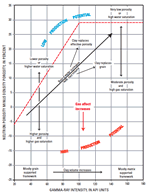 Abstract Abstract Cretaceous sandstones of east-central Alberta and
southern Saskatchewan, Canada, and eastern Montana, western North Dakota,
and parts of South Dakota and Wyoming, United States, are recognized
as a major source of natural gas. Although the potential for production
exists, the lack of commercial development is due to three major factors:
(1) the lack of pipeline infrastructure, (2) the lack of predictable
and reliable rates of production, and (3) the difficulty in recognizing
and selecting potentially productive gas-charged intervals. Unconventional
(tight), continuous-type reservoirs, such as those in the Cretaceous
of the northern Great Plains, are not well suited for formation evaluation
by conventional methods. To aid in the identification and selection of
potential gas-producing intervals, an index is developed here that empirically
links the “gas effect” (a geophysical-tool response to gas in a formation)
to gas production. The index combines the effects of porosity, water
saturation, and clay into a single value—the “gas-production index” (GPI)—that
relates in situ rock and fluids to gas-production potential. The fundamental
method for isolating the gas effect for calibration is to use a crossplot
of neutron porosity minus density porosity (N – D) versus gamma-ray intensity
(GR). In addition, an algorithm is developed to allow generation of the
GPI by computer using digital well logs.
|

 Abstract
Abstract 